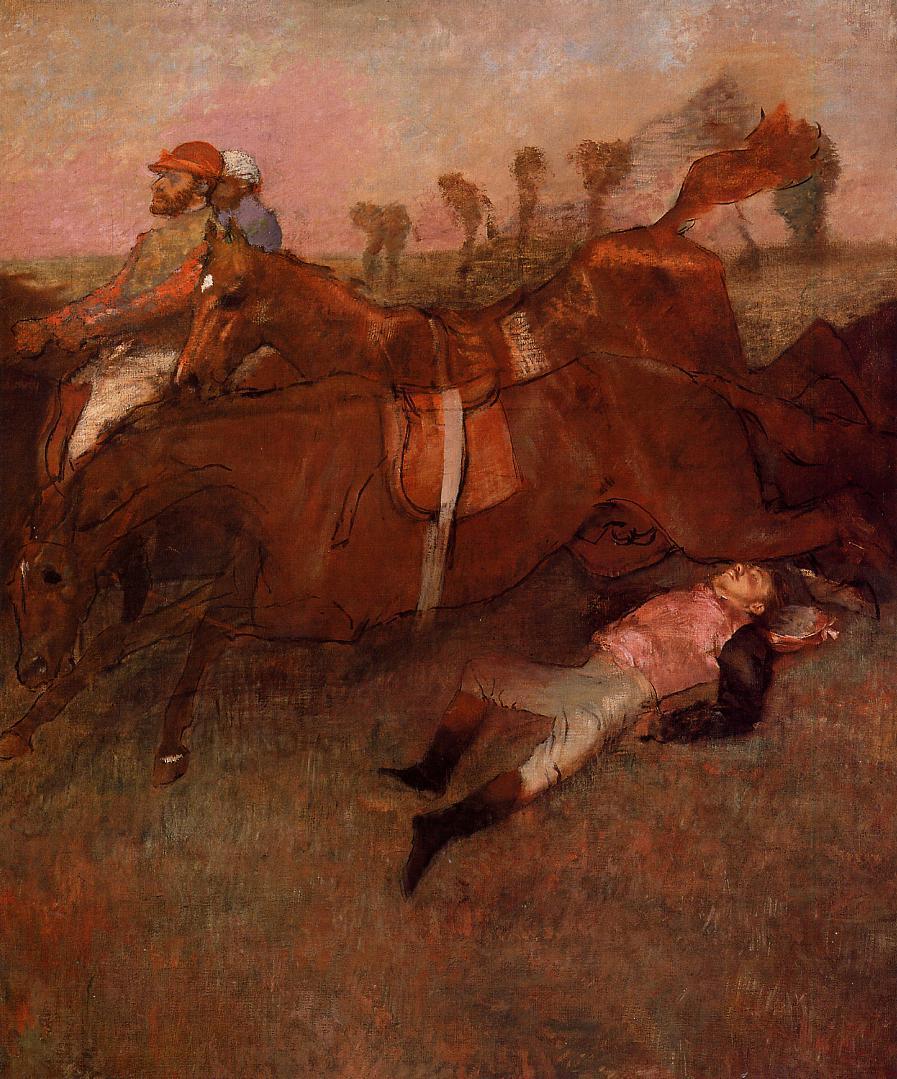art-Degas.com
Edgar Degas 1834-1917
Edgar Degas - Scene from the Steeplechase. The Fallen Jockey 1866
 Scene from the Steeplechase. The Fallen Jockey |
From National Gallery of Art, Washingon:
Scene from the Steeplechase: The Fallen Jockey was one of Degas' most ambitious early works. Painted in 1866 for exhibition at the Paris Salon, this painting marked a transition from the classically inspired history paintings of his youth toward the depiction of subjects drawn from modern life that would dominate his art for the rest of his career. The subject he chose was both fashionable and relatively novel: the steeplechase. First introduced into France in the 1830s, the steeplechase was—and remains today—a dangerous and at times controversial cross-country obstacle race. It had gained widespread popularity by the mid-1860s (the establishment of the Society of Steeplechases in 1863 had helped to legitimize the sport). Degas would have had ample opportunity to witness such races, perhaps while visiting his friends the Valpinçons at their estate in Ménil-Hubert in Normandy, a region renow ned for its horse farms a nd racetracks.
Degas' portrayal of the subject was highly dramatic, underscoring the peril inherent in a sport where falls are a common and potentially deadly occurrence. In this he may have been inspired by the ambitious composition exhibited two years earlier at the Salon of 1864, Episode from a Bullfight painted by his friend and sometime rival Edouard Manet, which had garnered considerable, if not entirely flattering, notice. Like Manet, Degas chose a rather generic title—Scene from the Steeplechase—as if he were merely documenting an anonymous, though potentially tragic, sporting accident.
The sense of immediacy the painting seeks to evoke contrasts sharply with the artist's own working method, which was complex and painstaking. Degas produced several preparatory drawings for this painting, including several of the fallen jockey for which the artist's younger brother Achille served as model. Despite his efforts, neither the contemporary appeal of the subject nor its impressive dimensions piqued the interest of the critics, and it passed largely unnoticed.
Soon after the exhibition closed, Degas appears to have reworked at least part of the canvas. It was but the first of at least three transformations carried out by the artist over the span of some thirty years. In 1880, with the intention of selling the painting to Alexander Cassatt, the brother of the painter Mary Cassatt, Degas began reworking the painting a second time, altering the original composition and introducing another horse. Dissatisfied with the results, Degas refused to release the painting. In a letter to her son, Cassatt's mother observed bleakly of the painting: "I doubt if he ever sells it—he says it is one of those works which are sold after a man's death & artists buy them not caring whether they are finished or not."
In the mid-to-late 1890s, Degas returned to this painting a third time, transforming its appearance even more dramatically by adding an overlay of vibrant color to the sky and the jockey's silks. Virtually every inch of the canvas was reworked with one notable exception: the delicately painted face of the fallen jockey—Achille, who had died in 1893—was left untouched. True to Mrs. Cassatt's prediction, the painting remained in the artist's studio until his death.